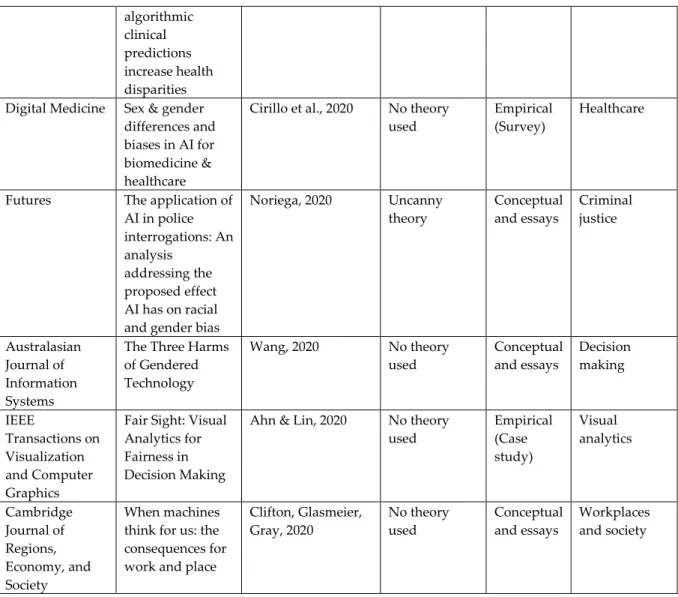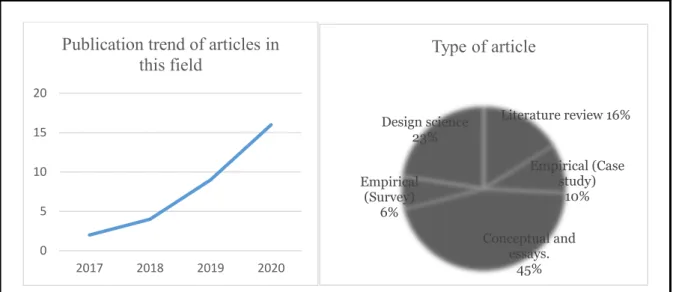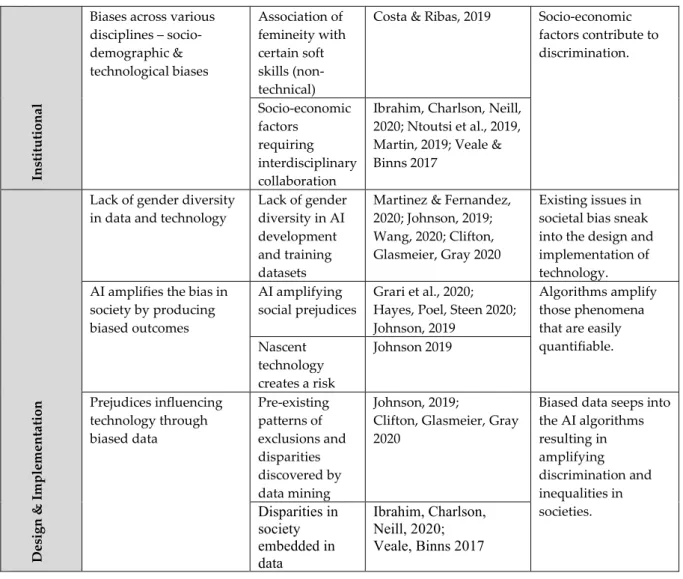The concern about gender bias in AI-based decision-making systems has also been raised by governments and research organizations (Parikh et al., 2019; Feast, 2019; Parsheera, 2018; . Agarwal, 2020). AI-based decision-making systems are now supporting the digital economy; at the same time, they are also criticized regarding their fairness, accountability and transparency (Feuerriegel et al., 2020). Furthermore, considerations of fairness in AI-based decision-making systems in organizations are still lagging behind, including fair practices within systems, people and processes (Feuerriegel et al., 2020).
This also includes a growing concern and re-examination of current approaches to introduce fairness into AI-based decision-making systems (Ntoutsi et al., 2019; The design of AI-based decision-making systems, including potential errors at this stage can affects the implementation and use of these systems (Marabelli et al., 2021) According to Feuerriegel et al. 2020, the lack of gender diversity in AI developers and other workers in science, technology, engineering and mathematics (STEM) careers reflects a homogenous IT industry , which is dominated by men, which can lead to a lack of diversity of thought in development teams (Johnson, 2019; Lee, 2018; Wang, 2020) developing AI decision-making systems.
In the context of AI-based decision-making systems, important contextual and external factors often go unnoticed (Marabelli et al., 2021). This biased behavior can be reflected in AI-based decision-making systems due to the unconscious biases of those who develop these systems (Clifton et al., Appropriate choices for AI-based decision-making systems must be made based on context, in which they are used (Marabelli et al., 2021).
When given authority, people who are actively involved in the final decision-making can effectively adjust the outcomes of the technical components of AI-based decision-making systems (Hayes et al., 2020).
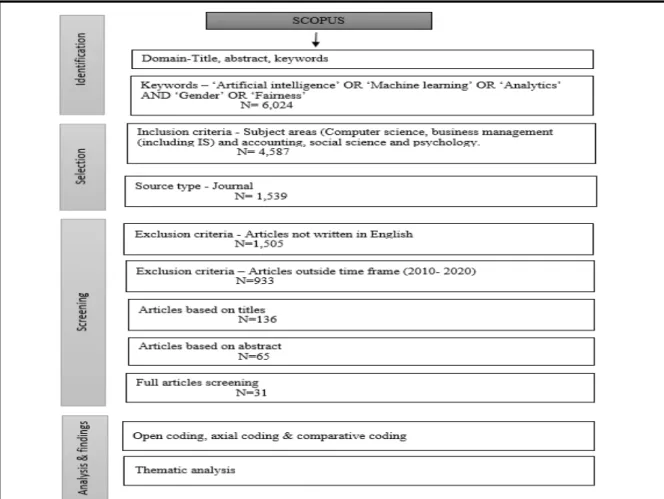
AI governance and regulatory approaches
Further training on inclusion and diversity for decision makers is also suggested as an approach to avoid unconscious bias and, more importantly, to understand and identify when to intervene in the proposed AI decision (Hayes et al., 2020) . Likewise, institution-wide education that incorporates ethics principles, such as promoting ethics education for every stakeholder involved in AI practices (Martin, 2019; Noriega, 2020), is reported to help detect biased outcomes. gender. Other education-based approaches include professional certifications and courses focused on building awareness of gender bias in AI-based decision-making systems (Martin, 2019).
Additionally, increased and improved AI corporate governance regarding gender inclusion in the development of AI technologies is suggested as a strategy to introduce diverse perspectives (Costa & Ribas, 2019; Johnson, 2019; Lee, 2018; Ntoutsi et al., 2019) and to ensure that gender bias is addressed in AI (Ibrahim et al., 2020). Improved gender diversity and inclusion in the technology sector, especially in the development of AI-based decision-making systems (Lambrecht & Tucker, 2019), is proposed to avoid homogenous and predominantly male-dominated management and decisions (Johnson, 2019). When applied to AI, the inclusion of a more diverse IT workforce in the design and implementation of algorithms and diversity of thought in AI development is reported to bring a multicultural perspective to AI design, which in turn can mitigate gender bias (Ibrahim et al. , 2020; Wu et al., 2019).
Organizations must also develop fair and ethical internal structures, corporate strategies and governance to manage gender imbalance; Gender diversity among board members, management, senior developers, and general leadership encourages people from diverse backgrounds and provides avenues toward mitigating gender bias (Johnson, 2019). Recognizing the need for knowledge sharing, the researchers propose online ethical collaborative platforms for all actors, which would enable organizations of different demographics to collaborate and share knowledge about appropriate and practical strategies to promote justice in AI systems (Soleimani et al., 2021; Veale & Binns, 2017).
Societal and community-focused approaches
5 Discussion and Contributions
The bias in AI-based decision-making systems cannot be corrected by simply fixing the decision-making algorithms; 'it is not an algorithmic problem', as stated by Teodorescu et al. AI-based decision-making systems are multidisciplinary phenomena that require the collaboration of experts representing technological, organizational and human perspectives (Marabelli et al., 2021). For this purpose, we systematically reviewed the existing literature and especially built on the previous work of Marabelli et al. 2021) and Kordzadeh & Ghasemaghaei (2021) to advance the conversation about possible technological, organizational, human and societal mitigation approaches.
As a result, we propose a theoretical framework for managing gender bias in AI-based decision-making systems (see Figure 4 below). As part of the proposed framework and as a summary of our findings, we offer four theoretical propositions for possible mitigation of gender bias in AI-based decision-making systems. Removing proxy variables of protected attributes and providing fair datasets from all groups and members of a community, i.e., diverse and inclusive datasets, are reported to be effective in mitigating gender bias in the design. and implementation of AI systems (Bellamy et al., 2018; Feuerriegel et al., 2020; Grari et al., 2020; Hayes et al., 2020; Miron et al., 2020; Veale & Binns, 2017).
Having a document or guide on fair datasets for developers can support fair outcomes and prevent unfairness in training data by ensuring fair data collection, data preparation and regularization of the training data to minimize unfairness (Bellamy et al., 2018; . Ntoutsi et al. , 2019). Such measures, which are strictly socio-technical approaches, could be the pairing of data scientists with social scientists to achieve interdisciplinarity for design and implementation and to effectively mitigate gender bias in AI-based decision-making systems (Marabelli et al., 2021). Further, improved and constant testing for algorithmic accountability and transparency can improve the understanding and explanation of bias detection of algorithmic models and structures (Ntoutsi et al., 2019).
AI regulations requiring the inclusion of key ethical standards (Ntoutsi et al., 2019; Wang, 2020), adherence to laws and policies for better AI governance, auditing, and gender diversity and inclusion in fair AI organizations (Feuerriegel et al ., 2020). ) all report reducing gender bias in AI-based decision-making systems. Therefore, we suggest that AI governance and regulatory approaches can be used to mitigate factors related to institutional factors (Feuerriegel et al., 2020; Ntoutsi et al., 2019; Wang, 2020). AI to be fair by design (Arrieta et al., 2020), implemented in organizations with fair AI policies and business models (Feuerriegel et al., 2020), involves implementing inclusive policies and regulations within organizations and providing algorithmic accountability and transparency (Johnson 2019; Ntoutsi et al., 2019).
Fair AI governance mitigation approaches through awareness and promotion of policies are reported to ensure that 'people are in the loop' increasing the chance of fairness provided by AI-based decision-making systems (Teodorescu et al., 2021). Therefore, we suggest that equitable AI governance approaches can be used to mitigate the institutional-related contributing factors (Hayes et al., 2020; Lee, 2018; Marabelli et al., 2021; Furthermore, certain public policies that protect fundamental rights and social well-being, if improved, brings awareness of human rights and works against gender bias and other discrimination (Clifton et al., 2020; Miron et al., 2020).
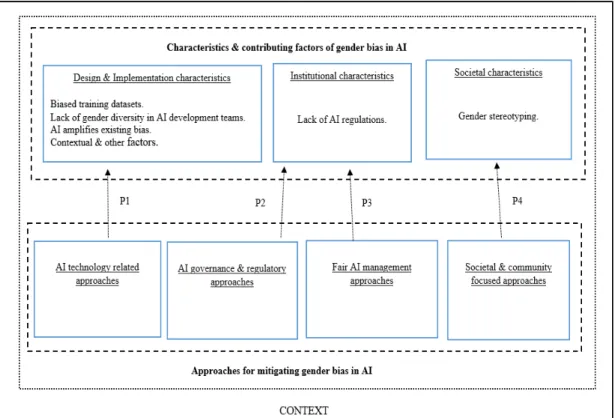
6 Future research
Gender bias in society is found to be replicated in emerging technologies, that is, including AI (Kordzadeh & Ghasemaghaei, 2021).
7 Concluding Remarks and Study Limitations
We view gender bias in AI-based decision-making systems as a socio-technical problem that affects various stakeholders, including the workforce and society at large. We identify some key features that exhibit gender bias in AI-based decision-making systems, along with associated contributing factors and potential mitigation approaches, developed based on existing literature and timely industry examples. Therefore, a framework is proposed to guide AI designers, developers and other stakeholders to ensure the governance of AI by mitigating gender bias in AI-based decision-making systems.
Our research results also suggest that organizations should be actively involved in implementing ethical and fair AI outcomes. In particular, our findings highlight strategies related to workplace diversity, further education on ethical and fair AI, and improved algorithmic transparency and accountability. Additionally, ethical and fair AI training and certification for new employees should be considered and periodically reinforced.
Additionally, organizations should have AI governance strategies in place that support the prevention, detection and mitigation of gender bias in their AI-based decision-making systems. In addition, a systematic literature review of the wider IS group and other journals, together with several databases such as the ISI Web of Science, could be used to obtain more detailed results.
Finally, as mentioned earlier, we also recognize the need for the empirical validation of the proposed framework and propositions. The strategic use of artificial intelligence in the digital age: systematic literature review and future research directions. Artificial Intelligence: Multidisciplinary perspectives on emerging challenges, opportunities and agenda for research, practice and policy.
Gender bias in artificial intelligence: the need for diversity and gender theory in machine learning. The application of artificial intelligence in police interrogations: An analysis focusing on the proposed effect AI has on racial and gender bias, cooperation, and false confessions. Ethical principles in machine learning and artificial intelligence: cases from the field and possible ways forward.
Appendix
There is a lack of diversity in AI developer teams and in the technology sector, which means there is a lack of diversity of thought in data preparation as unconscious biases seep into the training data at the data preparation stage. Employing a more diverse IT workforce to be involved in algorithm design and implementation.
